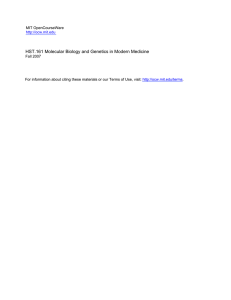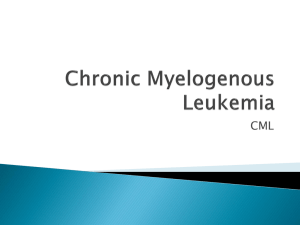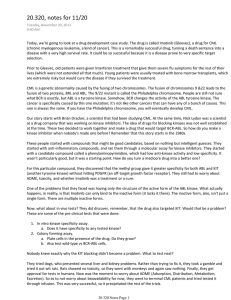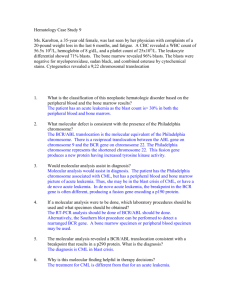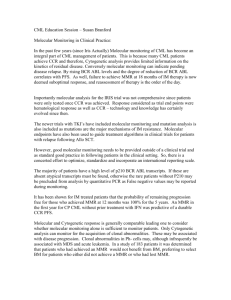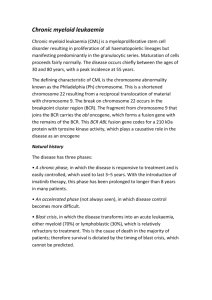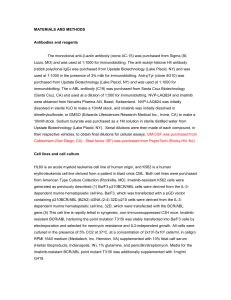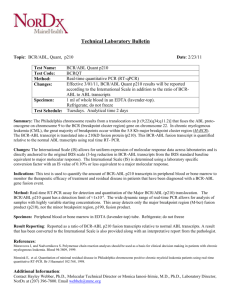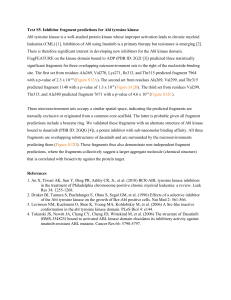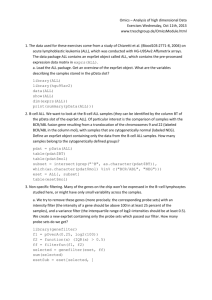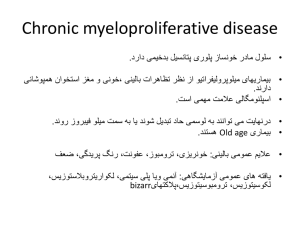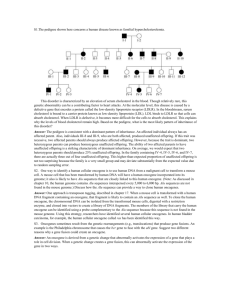Imatinib Resistance and the Difficulty of Eradicating Leukemia Stem
advertisement
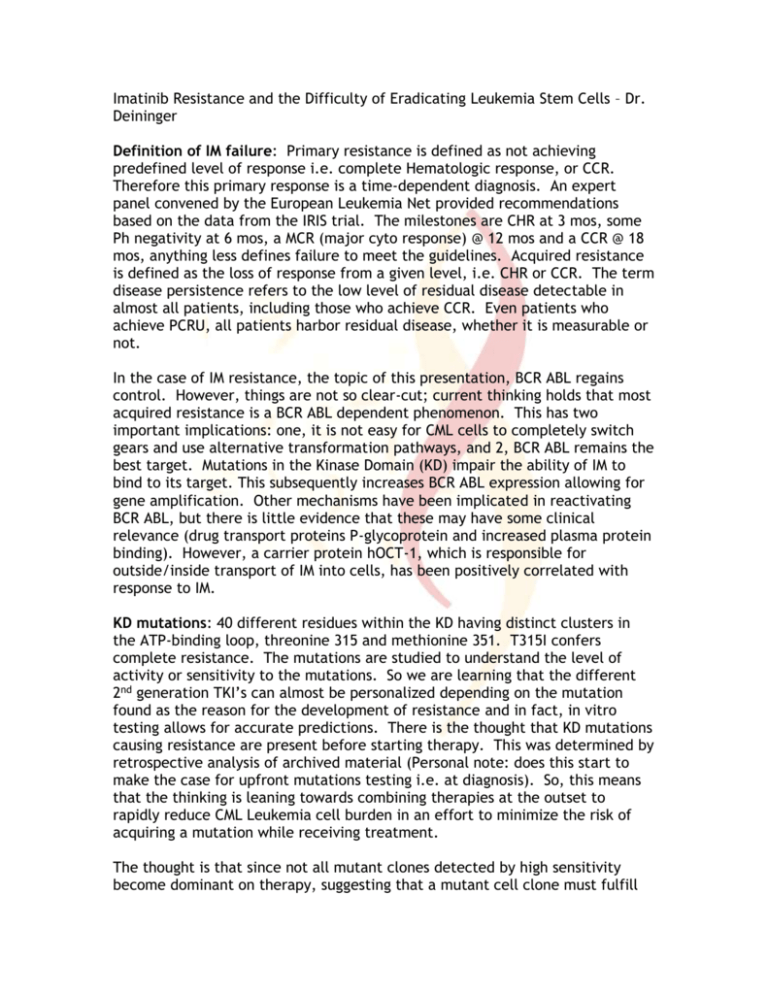
Imatinib Resistance and the Difficulty of Eradicating Leukemia Stem Cells – Dr. Deininger Definition of IM failure: Primary resistance is defined as not achieving predefined level of response i.e. complete Hematologic response, or CCR. Therefore this primary response is a time-dependent diagnosis. An expert panel convened by the European Leukemia Net provided recommendations based on the data from the IRIS trial. The milestones are CHR at 3 mos, some Ph negativity at 6 mos, a MCR (major cyto response) @ 12 mos and a CCR @ 18 mos, anything less defines failure to meet the guidelines. Acquired resistance is defined as the loss of response from a given level, i.e. CHR or CCR. The term disease persistence refers to the low level of residual disease detectable in almost all patients, including those who achieve CCR. Even patients who achieve PCRU, all patients harbor residual disease, whether it is measurable or not. In the case of IM resistance, the topic of this presentation, BCR ABL regains control. However, things are not so clear-cut; current thinking holds that most acquired resistance is a BCR ABL dependent phenomenon. This has two important implications: one, it is not easy for CML cells to completely switch gears and use alternative transformation pathways, and 2, BCR ABL remains the best target. Mutations in the Kinase Domain (KD) impair the ability of IM to bind to its target. This subsequently increases BCR ABL expression allowing for gene amplification. Other mechanisms have been implicated in reactivating BCR ABL, but there is little evidence that these may have some clinical relevance (drug transport proteins P-glycoprotein and increased plasma protein binding). However, a carrier protein hOCT-1, which is responsible for outside/inside transport of IM into cells, has been positively correlated with response to IM. KD mutations: 40 different residues within the KD having distinct clusters in the ATP-binding loop, threonine 315 and methionine 351. T315I confers complete resistance. The mutations are studied to understand the level of activity or sensitivity to the mutations. So we are learning that the different 2nd generation TKI’s can almost be personalized depending on the mutation found as the reason for the development of resistance and in fact, in vitro testing allows for accurate predictions. There is the thought that KD mutations causing resistance are present before starting therapy. This was determined by retrospective analysis of archived material (Personal note: does this start to make the case for upfront mutations testing i.e. at diagnosis). So, this means that the thinking is leaning towards combining therapies at the outset to rapidly reduce CML Leukemia cell burden in an effort to minimize the risk of acquiring a mutation while receiving treatment. The thought is that since not all mutant clones detected by high sensitivity become dominant on therapy, suggesting that a mutant cell clone must fulfill additional requirements, such as occurring in a cell with a self-renewal capacity. Other observations may suggest that some KD mutations may alter the biology of the disease in addition to conferring resistance by modulating basal intrinsic Kinase activity or by altering signal transduction. Imatinib Resistance of Undetermined Etiology The frequency of KD mutations with resistant disease varies according to disease phase and resistance type. Many patients have increased BCR ABL but are mutation negative, so it is evident that for many patients, the mechanism of resistance remains obscure. The bottom line being that although KD mutations are intriguing but has to some extent, distracted attention from the analysis of other resistance mechanisms. As well, all the studies have focused on the leukemia cell; the role of the microenvironment has not been explored. So far all that has been discussed here refers to IM resistance and mutations, which is a weak ABL inhibitor when compared to Nilotinib and Dasatinib. When thinking about extremely potent ABL kinase inhibitors we might learn more about the biology of the disease. There is some thought that if leukemia responds to potent ABL inhibitors, then it has identified itself as BCR ABL dependent, it is addicted t this oncoprotein, so relapse will take the same route. Additionally, failure to respond to a potent ABL inhibitor such as Dasatinib implies that BCR ABL independence, and one could argue that these leukemia’s are no longer to be considered CML. The only time the potent ABL inhibitor wouldn’t work but still be defined as CML would be in the presence of T315I, here we have seen some activity of SGX393 (personal note: there are other molecules as well that are showing activity against T315I such as Omacetaxine). Disease Persistence: CML is thought to originate in the hematopoietic stem cell, which is transformed through the acquisition of the BCR ABL translocation. Evidence: one, BCR ABL is present in stem cells of all hematopoietic lineages, although not all lineages are equally subject to leukemic transformation, with granulocytes and their precursors forming the bulk of the leukemic clones, 2 nd, responses to multiagent chemotherapy, which is curative for many patients with acute leukemia, are inevitably transient in CML. Patients who achieve PCRU for quite some time and stop IM eventually relapse, the only patients who don’t relapse are those who have received prior therapy with Interferon. This would suggest an immunologic control. It is not clearly understood why IM does not get to the root of the problem. Ex-vivo studies using primitive cells from IM naïve chronic phase disease have shown that the effects of IM are primarily cytostatic and that noncycling quiescent leukemic stem cells are insensitive to the drug or are even enriched in its presence and to a lesser degree in Dasatinib. It has been established that these cells are equivalent to the CML stem cells that persist in patients. There is also some thought that CML stem cells may rely on physiologic signals that may not be oncogene addicted, however this hypothesis needs to be tested and would involve understanding more about the microenvironment. Prospects for Disease eradication: If disease persistence is based on BCR ABL dependency then better inhibitors will be needed, however if CML stem cells do not require BCR ABL activity, then this would be a natural limit for ABL kinase inhibitors therapy. Again this points to understanding the microenvironment, such as integrins or cytokines that promote survival in the presence of ABL inhibitors. GM-CSF intercepting with JAK2 inhibitor can be beneficial. The alternative is immunotherapy, breakpoint peptides as vaccines is appealing. The most promising results are seen with patients with low level of persistence disease. Nonspecific immunotherapy such as PR-1, a peptide derived from myeloperoxidase has been detected for patients who experience a CCR to IFN but not to IM. There needs to be closer investigation to see if such responses are detectable from patients who had prior exposure to IFN therapy. Of note is that myeloperoxidase expression in CML cells is regulated by BCR ABL kinase activity. Inhibition of BCR ABL with ABL kinase inhibitor could down regulate the very antigen that is crucial for the immune responses implying that the timing of IM and IFN may be crucial.
